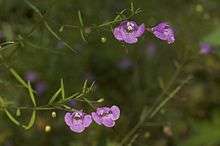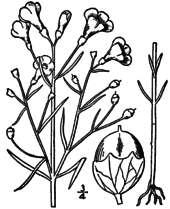Agalinis tenuifolia
Agalinis tenuifolia, known by the common names common gerardia,[2] slender false foxglove[2] or common false foxglove, is an annual forb native to the eastern and southwestern United States, and Canada,[3] which produces purple flowers in late summer or early fall.
| Agalinis tenuifolia | |
|---|---|
 | |
| Scientific classification | |
| Kingdom: | Plantae |
| Clade: | Tracheophytes |
| Clade: | Angiosperms |
| Clade: | Eudicots |
| Clade: | Asterids |
| Order: | Lamiales |
| Family: | Orobanchaceae |
| Genus: | Agalinis |
| Species: | A. tenuifolia |
| Binomial name | |
| Agalinis tenuifolia | |
| Synonyms [1] | |
Description

Agalinis tenuifolia is 20 to 60 centimeters tall, with a slender, paniculately branched stem. Its simple opposite leaves are 20 to 50 millimeters long, and only 1 to 3.5 millimeters wide. The flowers are borne on 10 to 20 millimeter long pedicels. Each flower is bilaterally symmetrical, with five 10 to 15 millimeter long petals fused into a corolla tube, and four stamens. The fruit is a round 3 to 7 millimeter long dry capsule that splits open when ripe.[4][5]
Distribution and habitat
Agalinis tenuifolia is widely distributed in the eastern United States and Canada, although local distribution may be spotty. It has been recorded in the states of Alabama, Arkansas, Colorado, Connecticut, Washington, D.C., Delaware, Florida, Georgia, Iowa, Illinois, Indiana, Kansas, Kentucky, Louisiana, Massachusetts, Maryland, Maine, Michigan, Minnesota, Missouri, Mississippi, North Carolina, North Dakota, Nebraska, New Hampshire, New Jersey, New Mexico, New York, Ohio, Oklahoma, Pennsylvania, Rhode Island, South Carolina, South Dakota, Tennessee, Texas, Virginia, Vermont, Wisconsin, West Virginia, and Wyoming, as well as the Canadian provinces of Manitoba, New Brunswick, Ontario, and Quebec. Agalinis tenuifolia is listed as a species of special concern in the state of Rhode Island.[3] In Virginia it grows in habitats including dry woods and barrens, but particularly in open disturbed areas such as old fields,[6] however, in Michigan, it grows in moist or even marshy ground, including river banks.[7] The presence of this species is dependent on appropriate habitat, and it may be eliminated from an area by development, changes in land use, or competition with invasive species.
Ecology
Like other members of the genus Agalinis, this species is hemiparasitic on a variety of hosts, particularly graminoids.[8] Agalinis tenuifolia uses haustoria to connect its roots with those of its host plants, but it also has green tissues, and performs photosynthesis.[5]
Taxonomy
This species is a member of the genus Agalinis, which was formerly placed in the family Scrophulariaceae, but has more recently been placed in the family Orobanchaceae, in keeping with the findings of the Angiosperm Phylogeny Group.[9]
References
- "Agalinis tenuifolia (Vahl) Raf. - The Plant List". Retrieved January 28, 2014. The Plant List (2013). Version 1.1. Published on the Internet; http://www.theplantlist.org/
- Common Gerardia (Slender Gerardia; Slender False Foxglove), Missouri Department of Conservation, archived from the original on 8 December 2015, retrieved 4 December 2015
- "Plants Profile for Agalinis tenuifolia (slenderleaf false foxglove)". Retrieved January 28, 2014. USDA, NRCS. 2014. The PLANTS Database (http://plants.usda.gov)%5B%5D. National Plant Data Team, Greensboro, NC 27401-4901 USA.
- Britton, Nathaniel Lord & Brown, Addison (1913). An Illustrated Flora of the Northern United States, Canada and the British Possessions: From Newfoundland to the Parallel of the Southern Boundary of Virginia, and from the Atlantic Ocean Westward to the 102d Meridian, Volume 3., p. 211. Charles Scribner's Sons, New York.
- "Agalinis tenuifolia (slender-leaved agalinis, slender-leaved false-foxglove): Go Botany". Retrieved January 28, 2014.
- "Digital Atlas of the Virginia Flora | Agalinis tenuifolia (Vahl) Raf. var. tenuifolia". Retrieved January 28, 2014. Virginia Botanical Associates. (2014). Digital Atlas of the Virginia Flora (http://www.vaplantatlas.org). c/o Virginia Botanical Associates, Blacksburg.
- "Agalinis tenuifolia - Michigan Flora". Retrieved January 28, 2014. MICHIGAN FLORA ONLINE. A. A. Reznicek, E. G. Voss, & B. S. Walters. February 2011. University of Michigan.(http://michiganflora.net)
- "Agalinis - Michigan Flora". Retrieved January 28, 2014. MICHIGAN FLORA ONLINE. A. A. Reznicek, E. G. Voss, & B. S. Walters. February 2011. University of Michigan.(http://michiganflora.net)
- Angiosperm Phylogeny Group. 2003. An update of the Angiosperm Phylogeny Group classification for the orders and families of flowering plants: APG II. Botanical Journal of the Linnaean Society 141:399-436., cited in Walter Fertig "Farewell to the Aceraceae: Changes in the Angiosperm Family Tree" (PDF). Archived from the original (PDF) on July 20, 2011. Retrieved February 8, 2014. The University of Montana Herbarium Newsletter. (Spring 2011). University of Montana, Missoula, MT. http://herbarium.dbs.umt.edu Archived 2014-03-06 at the Wayback Machine